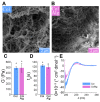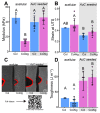Alginate Conjugation Increases Toughness in Auricular Chondrocyte Seeded Collagen Hydrogels
- PMID: 37760139
- PMCID: PMC10526064
- DOI: 10.3390/bioengineering10091037
Alginate Conjugation Increases Toughness in Auricular Chondrocyte Seeded Collagen Hydrogels
Abstract
Current auricular cartilage replacements for pediatric microtia fail to address the need for long-term integration and neocartilage formation. While collagen hydrogels have been successful in fostering neocartilage formation, the toughness and extensibility of these materials do not match that of native tissue. This study used the N-terminal functionalization of collagen with alginate oligomers to improve toughness and extensibility through metal-ion complexation. Alginate conjugation was confirmed via FTIR spectroscopy. The retention of native collagen fibrillar structure, thermal gelation, and helical conformation in functionalized gels was confirmed via scanning electron microscopy, oscillatory shear rheology, and circular dichroism spectroscopy, respectively. Alginate-calcium complexation enabled a more than two-fold increase in modulus and work density in functionalized collagen with the addition of 50 mM CaCl2, whereas unmodified collagen decreased in both modulus and work density with increasing calcium concentration. Additionally, the extensibility of alginate-functionalized collagen was increased at 25 and 50 mM CaCl2. Following 2-week culture with auricular chondrocytes, alginate-functionalization had no effect on the cytocompatibility of collagen gels, with no effects on cell density, and increased glycosaminoglycan deposition. Custom MATLAB video analysis was then used to quantify fracture toughness, which was more than 5-fold higher following culture in functionalized collagen and almost three-fold higher in unmodified collagen.
Keywords: collagen; complexation; extensibility; functionalization; toughness.
Conflict of interest statement
Bonassar is a co-founder of and holds equity in 3DBio Corp.
Figures





Similar articles
-
Integration of layered chondrocyte-seeded alginate hydrogel scaffolds.Biomaterials. 2007 Jul;28(19):2987-93. doi: 10.1016/j.biomaterials.2007.02.035. Epub 2007 Mar 5. Biomaterials. 2007. PMID: 17382380
-
Biochemical and structural characterization of neocartilage formed by mesenchymal stem cells in alginate hydrogels.PLoS One. 2014 Mar 13;9(3):e91662. doi: 10.1371/journal.pone.0091662. eCollection 2014. PLoS One. 2014. PMID: 24626259 Free PMC article.
-
Fabrication of chondrocytes/chondrocyte-microtissues laden fibrin gel auricular scaffold for microtia reconstruction.J Biomater Appl. 2021 Feb;35(7):838-848. doi: 10.1177/0885328220954415. Epub 2020 Sep 2. J Biomater Appl. 2021. PMID: 32875937
-
Tissue-engineered human nasal septal cartilage using the alginate-recovered-chondrocyte method.Laryngoscope. 2004 Jan;114(1):38-45. doi: 10.1097/00005537-200401000-00006. Laryngoscope. 2004. PMID: 14709992
-
Successful creation of tissue-engineered autologous auricular cartilage in an immunocompetent large animal model.Tissue Eng Part A. 2014 Jan;20(1-2):303-12. doi: 10.1089/ten.TEA.2013.0150. Epub 2013 Oct 4. Tissue Eng Part A. 2014. PMID: 23980800
Cited by
-
Recombinant Small Leucine-Rich Proteoglycans Modulate Fiber Structure and Mechanical Properties of Collagen Gels.ACS Biomater Sci Eng. 2025 Jul 14;11(7):4101-4115. doi: 10.1021/acsbiomaterials.5c00732. Epub 2025 Jun 13. ACS Biomater Sci Eng. 2025. PMID: 40509883 Free PMC article.
-
siRNA Treatment Enhances Collagen Fiber Formation in Tissue-Engineered Meniscus via Transient Inhibition of Aggrecan Production.Bioengineering (Basel). 2024 Dec 23;11(12):1308. doi: 10.3390/bioengineering11121308. Bioengineering (Basel). 2024. PMID: 39768126 Free PMC article.
-
3D printing tissue-engineered scaffolds for auricular reconstruction.Mater Today Bio. 2024 Jul 2;27:101141. doi: 10.1016/j.mtbio.2024.101141. eCollection 2024 Aug. Mater Today Bio. 2024. PMID: 39045312 Free PMC article. Review.
References
Grants and funding
LinkOut - more resources
Full Text Sources

